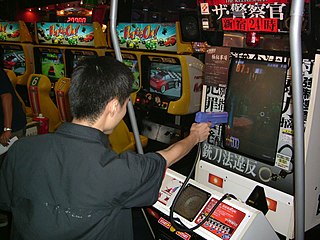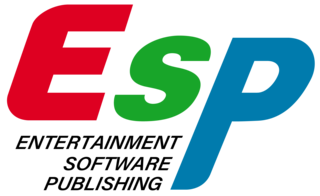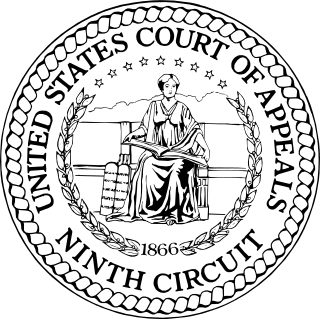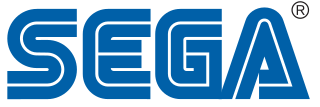
The 3DO Interactive Multiplayer, commonly referred to as 3DO, is a home video game console developed by The 3DO Company. Conceived by entrepreneur and Electronic Arts founder Trip Hawkins, the 3DO was not a console manufactured by the company itself, but a series of specifications, originally designed by Dave Needle and R. J. Mical of New Technologies Group, that could be licensed by third parties. Panasonic produced the first models in 1993, and further renditions of the hardware were released in 1994 by GoldStar, and in 1995 by Sanyo.

An arcade video game takes player input from its controls, processes it through electrical or computerized components, and displays output to an electronic monitor or similar display. Most arcade video games are coin-operated, housed in an arcade cabinet, and located amusement arcades alongside other kinds of arcade games. Until the late 1990s, arcade video games were the largest and most technologically advanced segment of the video game industry.

The Master System is a third-generation 8-bit home video game console manufactured by Sega. It was originally a remodeled export version of the Sega Mark III, the third iteration of the SG-1000 series of consoles, which was released in Japan in 1985 and featured enhanced graphical capabilities over its predecessors. The Master System launched in North America in 1986, followed by Europe in 1987, and Brazil in 1989. A Japanese version of the Master System was also launched in 1987, which features a few enhancements over the export models : a built-in FM audio chip, a rapid-fire switch, and a dedicated port for the 3D glasses. The Master System II, a cheaper model, was released in 1990 in North America and Europe.
Jaleco Ltd. was a corporate brand name that was used by two previously connected video game developers and publishers based in Japan. The original Jaleco company was founded in 1974 as Japan Leisure Company, founded by Yoshiaki Kanazawa, before being renamed to simply Jaleco in the early 1980s. This company was later acquired in 2000 by PCCW, who rebranded it as their Japanese game division, PCCW Japan, before reverting it to Jaleco in 2002. In 2006, Jaleco became independent from PCCW and renamed to Jaleco Holding, having their video game operations spun off into a new company, also called Jaleco. This new spin-off company was sold to mobile developer Game Yarou in 2009, with Jaleco Holding renaming itself to Encom Holdings shortly after.
In the history of computer and video games, the fourth generation of game consoles began on October 30, 1987 with the Japanese release of NEC Home Electronics' PC Engine. Although NEC released the first console of this era, sales were mostly dominated by the rivalry between Nintendo's and Sega's consoles in North America: the Super Nintendo Entertainment System and the Sega Genesis. Cartridge-based handheld consoles became prominent during this time, dominated by the Nintendo Game Boy (1989). Color handhelds were also released. including the Atari Lynx (1989) and Sega Game Gear (1990).
Sega Meganet, also known as the Net Work System, was an online service for the Mega Drive in Japan and later Brazil. Utilizing dial-up Internet access, Meganet was Sega's first online multiplayer gaming service, and functioned on a pay to play basis. The system functioned through the use of a peripheral called the Mega Modem and offered several unique titles that could be downloaded, and a few could be played competitively with friends. In addition, it shared technology and equipment with more serious services such as the Mega Anser, used for banking purposes. Though the system was announced for North America under the rebranded name "Tele-Genesis", it was never released for that region. Ultimately, the Meganet service would be short-lived, lasting approximately a year before it was discontinued, but would serve as a precursor to the Sega Channel and XBAND services, as well as a predecessor to online gaming services for video game consoles. Retrospective feedback praises the attempt by Sega to introduce online gaming, but criticizes the service for its logistical issues and lack of titles.
In the history of computer and video games, the third generation began on July 15, 1983, with the Japanese release of two systems: the Nintendo Family Computer and the Sega SG-1000. When the Famicom was released outside of Japan it was remodelled and marketed as the Nintendo Entertainment System (NES). This generation marked the end of the video game crash of 1983, and a shift in the dominance of home video game manufacturers from the United States to Japan. Handheld consoles were not a major part of this generation, although the Game & Watch line from Nintendo and the Milton Bradley Microvision were sold at the time. However, both are considered second generation hardware.

Virgin Interactive Entertainment was the video game publishing division of British conglomerate the Virgin Group. It was formed as Virgin Games in 1983. Initially built around a small development team called the Gang of Five, the company grew significantly after purchasing budget label Mastertronic in 1987.
Ocean Software Ltd was a British software development company that became one of the biggest European video game developers and publishers of the 1980s and 1990s.
1992 saw many sequels and prequels in video games, such as Dragon Quest V, Final Fantasy V, Sonic the Hedgehog 2, Super Mario Land 2: 6 Golden Coins, and Super Mario Kart, as well as several new titles such as Art of Fighting, Mortal Kombat and Virtua Racing.
A Mahjong video game is a video game that is based on the classical Chinese game mahjong. However, many mahjong video games, especially among those released in Western territories, do not depict the actual game of mahjong but rather mahjong solitaire.

The Sega Genesis, known as the Mega Drive outside North America, is a 16-bit fourth-generation home video game console developed and sold by Sega. The Genesis was Sega's third console and the successor to the Master System. Sega released it in 1988 in Japan as the Mega Drive, and in 1989 in North America as the Genesis. In 1990, it was distributed as the Mega Drive by Virgin Mastertronic in Europe, Ozisoft in Australasia, and Tec Toy in Brazil. In South Korea, it was distributed by Samsung as the Super Gam*Boy and later the Super Aladdin Boy.

Entertainment Software Publishing, Inc. (ESP) was a Japanese video game publisher headquartered in Shibuya, Tokyo. It was founded in 1997 as a publisher for games developed by the Game Developers Network (GD-NET). GD-NET, which included companies such as Treasure and Game Arts, was established due to concerns over smaller developers not having the same financial backing like larger game companies did, as production of console games was beginning to rise. ESP was best known for publishing shoot 'em ups and role-playing games. While primarily a publisher, ESP also developed a handful of games internally.
ADK Corporation, formerly known as Alpha Denshi Corporation (アルファ電子株式会社), was a Japanese video game developer founded in 1980. ADK began as a developer of arcade games and is best known for their library of SNK Neo Geo titles, including for its home consoles, produced in partnership with SNK. Most notable among these are their fighting games and, in particular, the World Heroes series and Aggressors of Dark Kombat. The company closed with properties sold to SNK Playmore in 2003.

Sol-Feace is a 1990 horizontal-scrolling shooter video game developed by Wolf Team and published by Telenet Japan for the Sharp X68000 computer. Versions for the Sega CD and Sega Genesis were released later on, the latter renaming the game Sol-Deace. The player takes control of the titular starship as it must prevent a malfunctioning supercomputer from enslaving all of mankind. Gameplay involves shooting down enemies and avoiding projectiles, while collecting power capsules to increase the Sol-Feace's abilities. The Sol-Feace also has dual cannons that can fire shots diagonally.

Sega Enterprises Ltd. v. Accolade, Inc., 977 F.2d 1510, is a case in which the United States Court of Appeals for the Ninth Circuit applied American intellectual property law to the reverse engineering of computer software. Stemming from the publishing of several Sega Genesis games by video game publisher Accolade, which had disassembled Genesis software in order to publish games without being licensed by Sega, the case involved several overlapping issues, including the scope of copyright, permissible uses for trademarks, and the scope of the fair use doctrine for computer code.

Gamtec is a Taiwanese video game developer established in June 1989 and based in Taichung City, Taiwan noted for its unlicensed Sega Mega Drive games such as Legend of Wukong and Squirrel King. His motto would have to be: Believe in yourself.

Sega Corporation is a Japanese multinational video game developer and publisher headquartered in Shinagawa, Tokyo. Its international branches, Sega of America and Sega Europe, are headquartered in Irvine, California, and London. Its division for both console and arcade video game development, Sega Games, has existed in its current state since 2020; from 2015 to that point, the two had made up separate entities known as Sega Games and Sega Interactive Co., Ltd.. Sega is a subsidiary of Sega Group Corporation, a part of Sega Sammy Holdings. From 1983 until 2001, Sega also developed video game consoles.
Nihon Bussan Co. Ltd. was a Japanese video game developer and publisher headquartered in Kita, Osaka. In the past they had also manufactured and sold yachts.
In the video game industry, a console war describes the competition between two or more video game console manufacturers in trying to achieve better consumer sales through more advanced console technology, an improved selection of video games, and general marketing around their consoles. While console manufacturers are generally always trying to out-perform other manufacturers in sales, these console wars engage in more direct tactics to compare their offerings directly against their competitors or to disparage the competition in contrast to their own, and thus the marketing efforts have tended to escalate in back-and-forth pushes.









